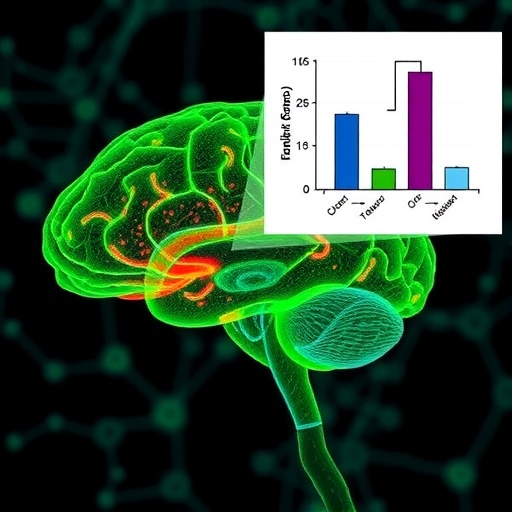Proof-of-concept shows genes implicated in Alzheimer’s disease can be accurately edited, with 90 percent efficiency in human stem cells

Credit: Arizona State University
During the past decade, the gene editing tool CRISPR has transformed biology and opened up hopeful avenues to correct deadly inherited diseases. Last fall, scientists began the first human clinical trials using CRISPR to combat diseases like cancer. They remove some of a person’s cells, CRISPR edit the DNA, and then inject the cells back in, where hopefully, they will cure the disease.
But along with this promise of regenerative, personalized medicine, CRISPR can also have significant safety limitations. CRISPR may not edit in the right place (so-called off-target gene effects) or not being terribly efficient (successful editing may only be achieved in about 10% of the time for every available cell target).
These limitations have frustrated scientists such as Arizona State University’s David Brafman, a cell bioengineer. Brafman initial hopes are to use gene editing to get at the heart of uncovering the causes of studies in his lab of neurodegenerative diseases like Alzheimer’s.
“We study neurodegenerative diseases like Alzheimer’s and use stem cells to study specific mutations or risk factors associated with Alzheimer’s disease,” said Brafman, a biomedical engineering faculty member in ASU’s Ira A. Fulton Schools of Engineering. “We are not necessarily a gene-editing tool development lab, but we were running into difficulty generating stem cell lines by using a traditional CRISPR-based editing approach. For reasons that are still unknown, stem cells are really resistant to that sort of genetic modification.”
Green light means go
Now, Brafman, using a new update to the CRISPR base editing technology originally developed in the lab of David Liu at Harvard, has vastly outperformed previous efforts by making highly accurate, single DNA base editing with an efficiency of up to 90% of human stem cells. The results were published in the journal Stem Cell Reports.
“Previously, with CRISPR, it’s just been a random guess,” said Brafman. “And so, if you are picking at random stem cells and the efficiency is low, you’ll likely get only 10% or 5% because you have no idea if the edits have been made — the cell isn’t telling you.”
Brafman’s lab has developed a new TREE method (an acronym short for transient reporter for editing enrichment, or TREE), which allows for bulk enrichment of DNA base-edited cell populations—-and for the first time, high efficiency in human stem cell lines.
“”Most of the studies are done in immortalized cell lines or cancer cell lines, which are relatively easy to edit,” said Brafman. “This is the first example of using base editors in pluripotent stem cells, which is a very valuable cell population to genetically modify. We envision this method will have important implications for the use of human stem cell lines in developmental biology, disease modeling, drug screening and tissue engineering applications,”
Last year, they had shown that their TREE approach can work in human cell lines, but wanted to further push the technology further to find a way to rapidly and efficiently edit human stem cell lines.
Unlike CRISPR, which cuts across both DNA stands, their TREE method only makes a single strand nick in DNA. For example, when a single DNA base is successfully edited from a C to a T, a protein gives off a signal, turning from blue to green.
“Now, if a cell is telling you, ‘if I’m glowing green I have a 90% chance of being edited you are going to have better luck identifying edited populations,” said Brafman. “Then, you can exclude all of the cells that are not edited. We isolate single cells that are glowing green, then grow those up into clonal populations that you are able to expand indefinitely.”
Targeting Alzheimer’s
Pluripotent stem cells are valued for regenerative medicine because they have the ability to become or differentiate into any cell type in the human body.
Brafman explains that there are two general sources, “embryonic stem cells, which are derived from the inner cell mass of a preimplantation blastocyst, and then there are induced pluripotent stem cells, which are derived from taking somatic cells like skin or blood from patients.”
Brafman’s lab uses the induced pluripotent stem cells for their research.
“For this study, we used pluripotent stem cells from both healthy patients and then patients with Alzheimer’s disease. Some of the genes that we were interested in modulating are related to Alzheimer’s disease. The majority of the patients suffering from Alzheimer’s disease suffer from late onset, or sporadic Alzheimer’s disease.”
To provide their proof-of-concept, they targeted the APOE gene, which can come in three flavors. One of the three gene variants, called APOE4, has been associated with a higher risk for late onset Alzheimer’s disease. For the study, they introduced single DNA based edits into the APOE gene.
“That’s why we are interested in having these cells,” said Brafman. “They are representative of the neurons and the various cell types in the central nervous system with patients with these various risk factors. Then, we can understand why an APOE variant can increase or decrease risk, and then we can start targeting those pathways that are affected.”
Not only could TREE make single DNA edits to the APOE4 gene, but unlike CRISPR, make highly accurate corrections to both copies of the APOE4 gene that humans possess.
“The traditional CRISPR approach is that you have to edit once to get a heterozygous edit , then isolate that clone, edit again to get another heterozygous edit,” said Brafman. “So, it’s very inefficient in that way. We are generating homozygous edits at an efficiency approaching 90%. I haven’t seen any other technologies that can do that in pluripotent stem cells.”
In addition, TREE could also be used to engineer critical gene knockout mutations into stem cell lines. “The most fundamental experiment you can do if a gene has important implications in disease, development or physiology is knock it out,” said Brafman. That opens up a whole bunch of questions that we can address. Using APOE as a case study, now we can knock out APOE in these cells if you don’t have APOE at all. Is it beneficial? Detrimental? Or no difference?”
Complex cases
While diseases like sickle-cell anemia or cystric fibrosis are caused by single mutations in DNA, for most diseases and leading causes of death, like heart disease or high blood pressure, are complex, and involve multiple genes. Brafman wanted to also address the complex, root causes of Alzheimer’s.
“Especially as it related to Alzheimer’s disease, there can be multiple risk factors that act in concert, so we wanted a way to introduce multiple edits simultaneously in pluripotent stem cells. Because otherwise, you would have to take this sequential iterative approach, where you introduce one edit, isolate a clonal population introduce another edit, and so on.
They successfully demonstrated that TREE could be used to make new stem cell lines that had been simultaneously edited at multiple gene locations. Their results showed that more than 80% of stem clones had been targeted at all three different gene sites, and with all clones editing both gene copies.
“We found that if you multiplex you still get the same efficiency of editing as you would if you just edited a single allele,” said Brafman. “Now, we can use these cells as in vitro models to study the disease and screen drugs.”
Brafman is hopeful that their new tools will generate excitement in the gene editing community, and spur others on to make new discoveries.
“We want to keep expanding on that toolbox,” said Brafman. “We’ve already gotten a high level of interest from other scientists who will be using this to generate their own cell lines. That’s a good thing.”
###
Funding for this work was provided by the National Institutes of Health (R01GM121698 to David Brafman, R21AG056706 to D.A.B, R01GM106081 to X.W.) and the Arizona Biomedical Research Commission (ADHS16-162401 to D.A.B).
Media Contact
Joseph Caspermeyer
[email protected]
480-258-8972
Related Journal Article
http://dx.





